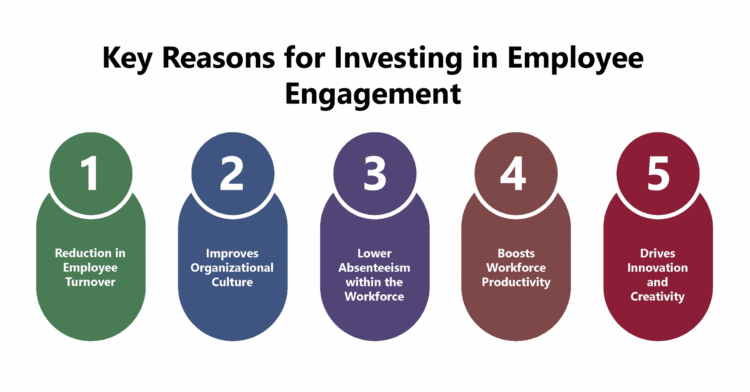1. Reduces Employee Turnover: Investing in employee engagement lowers turnover rates by increasing job satisfaction, reducing financial losses, and maintaining workflow stability.
2. Improves Organizational Culture: Engaged employees contribute to a positive work culture by fostering teamwork, motivation, and a stress-free environment, enhancing cooperation.
3. Lowers Absenteeism: Highly engaged employees are more likely to be present and committed, reducing absenteeism and inspiring others to maintain high performance.
4. Boosts Productivity: Engaged employees are more dedicated and motivated, increasing productivity and commitment to organizational growth and success.
Employees who feel unhappy and stressed at work tend to be less productive, which negatively impacts the organization’s performance and efficiency. Hence, investing in employee engagement is critical for organizations to ensure business growth and profitability.

Employee engagement has become the key to building a highly motivated workforce.
An engaged workforce is known to outperform a workforce with low engagement levels by a significant margin.
This is because engaged employees are likelier to show higher commitment and dedication to organizational growth and success.
Such employees tend to make every effort to maximize their productivity, indulge in less absenteeism, and even work towards inspiring and motivating their coworkers to improve their performance constantly.
Moreover, having an engaged workforce also helps in enhancing the employer brand value of the organizations.
This makes it easier for these organizations to attract the industry’s most skilled and competent candidates.

When employees have higher levels of engagement, they develop a sense of pride and happiness in their jobs.
There is no denying the fact that employee engagement can offer a wide range of benefits to organizations.
Thus, investing in employee engagement is critical for organizations to improve their growth and bottom–line.
Discussed below are a few of the key reasons why investing in employee engagement makes sense:
1. Reduction in Employee Turnover
2. Improves Organizational Culture
3. Lower Absenteeism within the Workforce
4. Boosts Workforce Productivity
5. Drives Innovation and Creativity


Low engagement level is one of the biggest reasons employees seek job options elsewhere.
An increase in the number of such employees often results in higher turnover rates and this can have seriously damaging consequences for the organization.
Reducing turnover rates can enhance employee motivation and minimize workflow disruptions and financial losses.

Highly engaged employees are passionate about their work and committed to organizational growth.
They are willing to share their experience and skills to help their coworkers succeed in their assigned tasks.
Such employees make constructive efforts to make the overall work environment pleasing and relaxed.
They understand that working in a stress-free and fun-filled environment helps improve employee motivation levels significantly.
This helps in improving the overall work culture and ensures better coordination and cooperation between colleagues.

When the workforce is highly engaged, employees avoid missing work for trivial reasons. Such employees feel responsible for fulfilling their roles and responsibilities effectively and promptly.
This motivates them enough to come to work regularly and ensures that their teams or their organization do not have to bear the consequences of their absenteeism.
Such employees even act as a source of inspiration for other workforce members. They motivate their peers to enhance their dedication and performance levels to fulfill organizational goals promptly.

As mentioned, highly engaged workforce members prioritize their work above everything else. They are thus driven to give their best to every task and responsibility.
This ensures that they are consistently productive and deeply committed to the growth and success of their organization.
Such employees tend to seek an element of fun, challenge, and excitement in every task assigned to them.
Their only objective is to get the work done, and they do it with the highest quality standards. Thus, they are responsible for significantly boosting employee productivity.

Employees with higher engagement levels also tend to have higher happiness and satisfaction levels at the workplace.
This is because they are passionate about doing their work correctly and according to the desired quality standards, which enhances their self-worth.
Such employees are constantly seeking more effective and simpler ways to solve problems and improve the process of completing various tasks.
They are thus responsible for driving innovation and creativity within the workforce.
Given the rapidly increasing competitive levels in the industry, organizations can no longer afford to not invest in employee engagement initiatives. Most experts consider it to be one of the most critical contributing factors for ensuring sustained business growth and building competitive advantage.

Lead author: Sagar Chaudhuri, the Co-Founder and CEO of HiFives. He is an HR Tech Evangelist with over 25 years of corporate and entrepreneurship experience. In the past, Sagar has worked in leadership roles at companies such as Genpact, Infosys, and ICICI Bank. He has an engineering degree from IIT Kharagpur and an MBA from IIM Lucknow. Connect on LinkedIn
To stay updated on the latest HiFives blogs, follow us on Twitter (@MyHiFives)